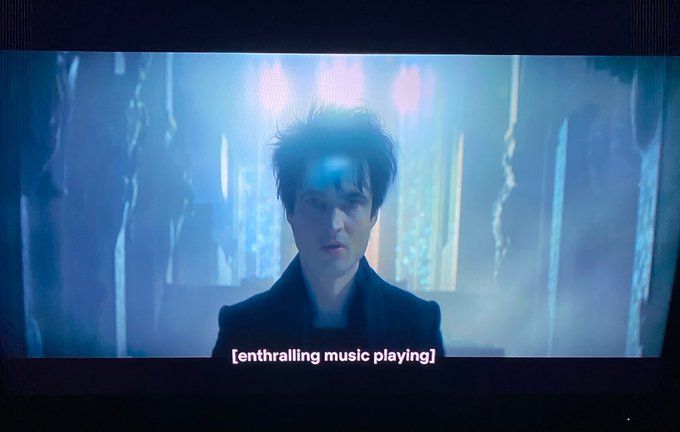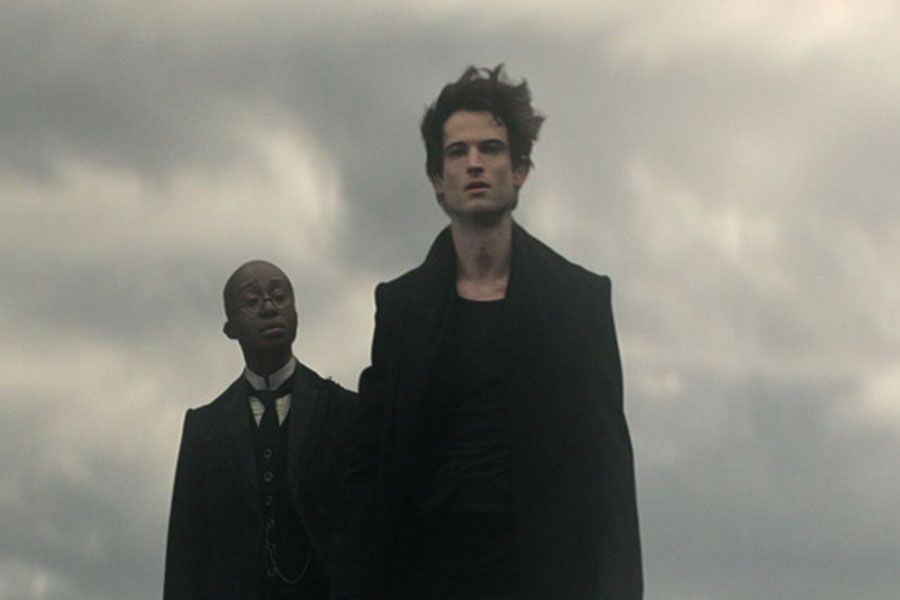I Watched Half Of The Sandman!

(Warning: sometimes I spoil and don't even notice.)
The last individual comic book I bought off the stand was the final issue of The Sandman in 1996. I was long over monthly superhero stuff, and Doom Patrol - the dollar-bin discovery that first got me into “mature readers” material - ended the year before. All other hipster titles I was purchasing had lost my interest, and shit was getting expensive ($2.95 for twentysome pages including tonally disruptive ads for extreme sodas and whatnot). With The Sandman, the grandest, most renowned mainstream series in the medium, reaching a climax, it made sense to say goodbye to the habit altogether. It’s been nothing but the occasional trade paperback - and more recently, online archive access - since.
I haven’t written about the Doom Patrol TV adaptation on here, yet, but - in case you don’t memorize my social media - my reaction has basically been euphoria. I’m downright misty-eyed in gratitude that my favorite comic from young adolescence has been adapted with such an intelligent mix of love and irreverence. You can tell they adore the ideas and iconography of the Grant Morrison run that blew my wee brain, but they haven’t let that keep them from adding characters and taking dramatic, intelligent twists that acknowledge what we’ve experienced and learned in the decades since it was released. Not everyone wants post-therapy feels and sassy banter between apocalyptic punch-outs after a decade plus of MCU content, but it’s been a delight to be reminded of old thrills without ever knowing how they’ll be presented or expanded upon. I’ll probably post a massive valentine here if and when that Discovery Channel exec straight out of the Bureau Of Normalcy lets me see Season 4.
Where I was flabbergasted they’d even consider a Doom Patrol show, Hollywood has tried to get The Sandman on screen since before I’d even read it. Drawings of a skinny magic goth boy named Dream interacting with ghouls, goblins, historical figures and hapless humans regularly entranced producers high on Tim Burton’s box office grosses. But eventually they’d realize a comic where everything stops for an issue-long celebration of A Midsummer Night’s Dream doesn’t translate into a 115-minute blockbuster format. Everyone from Jon “Can He Fight A Spider?” Peters to Joseph “Can He Shout-Out Morrissey?” Gordon-Levitt tried to develop it, but nobody even got close to production. Even through we now scroll through a world where Watchmen spin-offs, Ant-Man sequels and Doom Patrol seasons exist, with decades of failed folly behind it, I’m still a little stunned to see The Sandman now addable to lists.

All that build-up, and the media environment around it now, is probably why I’m a little nonplussed with the show. The first episode is basically the first issue of the comic, characters living impressively longer lives so that a British occultist can still trap a mystical mega-god circa World War I, but the mysterious, silent Bunnyman doesn’t escape naked from his prison until more than 30 years after he did in the comics. As they rush through the story and underplay the implications of his century-long imprisonment, I’d be surprised if anyone new to the material was particularly enthralled by it (above caption excepting). With all the J.R.R. and George R.R. we’ve seen in the 21st century, the CGI wonderland Dream’s pulled from looks like yet another CGI wonderland. And while Neil Gaiman’s comic was transparently derivative of Alan Moore's Swamp Thing (not to mention EC Comics and presumably horror novelists I’ve never read), the show avoids distracting us with tales of the victims of “sleeping sickness,” and loses most of its terror. If you don’t laugh when this pallid, powerful stranger finally comes forth from the mist and…subtly hides his dick from view while crouching down for some sand, you’re classier than me.
The following episodes are an improvement, the story’s quest underway and actors getting to act. Playing an immortal but trappable conceptual avatar with modern affectations that has to follow rules despite existing before our rules can NOT be easy, and Tom Sturridge does a great job of suggesting there’s not just a logic but a poetry to it all behind his eyes. His bassy growl - the character spoke in black balloons and white font in the book - actually makes sense once you see it come from his mouth (suck on that, Christian Bale). Sturridge gets that his job isn’t to make us understand everything, but to reward us for indulging the fantasy.
The show avoids many of the more grotesque moments of the book, but supporting characters manage to terrify all the same. I’ve never seen Gwendolyn Christie sans mask before, so I don’t know if she regularly brings audiences the wild-eyed intensity she gives Lucifer Morningstar here. But, Jesus Fucking Christ, I’ve never seen an actor take it to the bridge like this. She is a bonafide DARK ANGEL here. A nightmare of divine mission, psychotic delight and flaming fury too self-possessed to give us the relief of quivering camp like most effeminate evil overlords on screen. The way her face would flash right before she'd speak made me want to leap off the couch and hide. “I am a nova” is right. Jesus Fucking Christ. Dude’s lucky she didn’t respond to “I am hope” with “nah, you’re a bitch” and end the show right there. She had the right. I’m not including a picture of her as I genuinely don’t want to her appearance spoiled for you.
David Thewlis’ John Dee, though all too earthy in comparison to Lucifer, is almost as creepy. “24 Hours” was likely the most frightening issue of the series, a vicarious glimpse into a new god’s sociopathic curiosity, delight and then boredom with our human frailty. But where the comic portrayed Dee as a skeletal shell of a human, Thewlis plays him as just an old man in pajamas, haunted by his past and capable of empathy and compassion like anyone else. All that makes him different from us is a casual acceptance of his ability and freedom to rip a person or a planet in half. Despite enjoying the story and the actor for most of my life (I saw Naked not too many years after I read the issue), something about the screencap Thewlis posted on his Instagram almost made me afraid to watch it. It was as if he was threatening to make a childhood nightmare even more real than it felt at the time, infusing it with my own age & experience.

Through no fault of the veteran actor, the effect wasn’t quite pulled off. There are some changes made to Dee’s journey from the comic, and - while they diminish the chills somewhat - they’re intelligent and not uninspired. We’ve already witnessed a more contemptuous display of hypnotic authority on TV from David Tennant’s Kilgrave in Jessica Jones. Without combining the issues “24 Hours” and “Sound & Fury” into one episode, the former may have come off as mere torture-porn. The addition of an overt philosophical dimension to Dream and Dee’s battle has some poignancy. But I missed the chaos of the original story, and this is a show that could use some chaos.
By this point in the series, I’d checked Wikipedia and confirmed the show is run overwhelmingly by veteran TV hands, not filmmakers. Compared to Doom Patrol, or even the Marvel Disney+ shows, there’s rarely an inspired image or a setpiece that isn’t lifted directly from the comic, or a flight of fancy that takes the story into unexpected waters. It’s very much an adaptation of the book, one with craft but relatively limited imagination. Aside from one very specific distinction and perhaps the quality of CGI, it feels like something the BBC could have released twenty years ago. And it would have been a lot more impressive then.
That specific distinction is one I’m hesitant to bring up, because I don’t want to be misunderstood. It’s clear a lot of effort was made to bring racial diversity to the cast - or at least a lot more Black people. And I have ZERO beef with that in and of itself. But there’s a neoliberal superficiality to the inclusivity here, where race rarely if ever informs the characters. When a show is set in a specific historical period, and makes a healthy portion of the cast Black, it feels like an undue compliment to white people in the era to imply that nobody cared or noticed. (The question of racial inclusivity eliding the issue of historical racism has come up plenty in regards to Netflix's Bridgerton). Making Dream’s librarian a shaven-headed Black woman is cool, but how many bald Black women were rocking that gig in ye olden times? Was that an archetype and I’m just ignorant (I googled! Didn't find much before 1920, and nobody was shorn)? Or were they looking for characters - and in more than one case, corpses - they could raceflip in the name of progress without changing the story? (It’s worth noting that the credited directors and writers on The Sandman are overwhelmingly white, which underscores the issue of suggesting diversity in film is just a matter of changing skin tones and genders on established characters).

I haven’t watched the back half of the show yet - I already had plenty to say, more later I’m sure. I know Black women will portray the roles of both Death and Rose Walker. Walker in particular would be a terrific opportunity to investigate - or at least acknowledge - how race informs social experience, and I hope they do it. Again, this isn’t a white nerd getting fidgety when my screen is less white than I expected. Dealing with race is how the HBO Watchmen series more than justified expanding on Alan Moore's world. While the need to always have the Black guy be Cyborg is in an issue with DC Comics, I’m thoroughly impressed by what they’ve done with Cyborg on Doom Patrol, even though his character had jack to do with the original comics. But then, bringing Cyborg into an unrelated property and making it count is just the kind of risky effort The Sandman hasn't taken.
If all you want is a tasteful adaptation of the beloved comic, the show basically pulls it off. If you never respected why people liked that pretentious thing in the first place, this isn’t going to change your mind. In the last 30 years, we’ve gone from “please don’t judge the comic based on this weak adaptation” to “a lot of the stuff you liked isn’t really in the comic.” I can’t help but feel that The Sandman missed the memo.